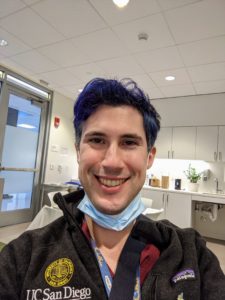I am now in my third year of residency, an age denoted as “Post-Graduate Year Three,” or PGY-3Post-graduate year. While a normal person might think this has to do with graduation from college, it’s actually counting the years of training that take place after medical school. After completing residency, any fellowships, and becoming an attending physician, they thankfully stop counting. That would get sad very quickly. More. Note that in this case, one is supposed to infer that “post-graduate” indicates graduating from medical school, even though it is university/college that is referred to as “undergraduate” education.
Further complicating my path, if I was in a Pediatrics or Internal Medicine resident, PGY-3Post-graduate year. While a normal person might think this has to do with graduation from college, it’s actually counting the years of training that take place after medical school. After completing residency, any fellowships, and becoming an attending physician, they thankfully stop counting. That would get sad very quickly. More would be my final year, meaning that I could be applying for fellowships or real jobs as an attending physician. Instead, as a Child Neurology resident, I spend the year starting over: moving from my position as a senior Pediatrics resident to a junior Neurology resident, a field that includes adult medicine. Because why not?
In (adult) Neurology world, I am paired with people who are also new to Neurology, but who have spent the previous year in Internal Medicine caring for adults. Simultaneously, in Child Neurology world, I got an office. Between all of my different roles, taking call, and the fact that neurological problems show a complete lack of respect for age, I now have badges at four different hospitals.
Here’s how the different program compare:
| Training Year | Pediatrics | Internal Medicine | Neurology | Child Neurology |
|---|---|---|---|---|
| PGY-1 | Intern | Intern | Intern (Internal Medicine) | Intern (Pediatrics) |
| PGY-2Post-graduate year. While a normal person might think this has to do with graduation from college, it’s actually counting the years of training that take place after medical school. After completing residency, any fellowships, and becoming an attending physician, they thankfully stop counting. That would get sad very quickly. More | Resident | Resident | Neurology Year 1 | Resident/Senior Resident (Pediatrics) |
| PGY-3Post-graduate year. While a normal person might think this has to do with graduation from college, it’s actually counting the years of training that take place after medical school. After completing residency, any fellowships, and becoming an attending physician, they thankfully stop counting. That would get sad very quickly. More | Senior Resident | Senior Resident | Neurology Year 2 | Neurology Year 1 |
| PGY-4Post-graduate year. While a normal person might think this has to do with graduation from college, it’s actually counting the years of training that take place after medical school. After completing residency, any fellowships, and becoming an attending physician, they thankfully stop counting. That would get sad very quickly. More | — | — | Neurology Year 3 | Child Neurology Year 1 |
| PGY-5Post-graduate year. While a normal person might think this has to do with graduation from college, it’s actually counting the years of training that take place after medical school. After completing residency, any fellowships, and becoming an attending physician, they thankfully stop counting. That would get sad very quickly. More | — | — | — | Child Neurology Year 2 |
Essentially, after getting familiar enough with Pediatrics that I could supervise interns, I became an intern again myself. With that returns the biggest struggle of intern year: figuring out how to wrestle the computer system into doing what I need.
Each EMR‘s individual peculiarities are black holes for time. Something that may have been routine at the children’s hospital now has a barrier in front of it, a metaphorical CAPTCHA that must be solved to achieve the desired outcome. The longer it takes to surmount the obstacle, the more likely it is that a new task will arrive with a higher importance and divert my attention, placing the original task on a growing list of undone items. This compounding effect is how one ends up still in the hospital at 2200, wondering forlornly where the daylight went.
To wit: after clicking “post,” I have to figure out why I can’t click “discharge patient” without also ordering a pneumococcal booster shot.*
*Among other indications, the 23-valent pneumococcal polysaccharide vaccine (PPSV23) is indicated in all adults ≥ 65 years of age and adults 19–64 years of age with chronic heart, liver, or lung disease, have cochlear implants, or who are smokers or alcoholic—populations who do not typically present to children’s hospitals.

